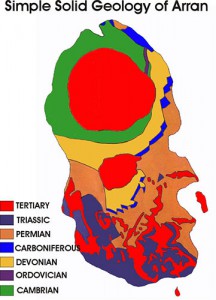Explore The Fascinating Geological Heritage of Arran

The island of Arran hosts a superb range of rock types that can be viewed in the field. It is a world class geological location, with fascinating geological outcrops, including the all important Hutton’s Unconformity. At the Arran Heritage Museum, there are displays on the geology of Arran, with samples of the rock types that can be found on the Island, fossils and palaeontological exhibits about Arran.
There is a short DVD that can be viewed as a simple introduction to the geology of the Island. There are mineral samples from the Island and images of Arran rocks, taken down a specialised petrological microscope. In the near future we hope to expand the geology section to give a more illustrative geological history of Arran. In the following pages we hope to give you a taste for the wonderful geology found on Arran via some examples of the different rock types that can be found on Arran and a simplified overview of the geological history of Arran .
You can take a virtual field trip to some classic geological localities on Arran. For those of you who are are interested in more detailed studies and explanations of the geology of Arran, a page of references and recommended reading has been attached. There is also a page with links to sites of interest relevant to Arran geology and palaeontology. We hope you will be inspired to come to Arran to look at the wonderful geology and visit the Heritage Museum. If you do decide to visit Arran to look at some rocks, please remember to consider safety in the field and follow the Geological Field Work Code, and remember to enjoy Arran’s wonderful geological heritage. We hope to update and add to this site on a regular basis, so drop by to see what’s new.

A panoramic view of the northern mountains of Arran,
they are composed of granite and formed during the Tertiary period.
The main rock types found on Arran were formed during the Cambrian (The Upper Dalradian) (590-505 million years ago or Ma), the Ordovician Period (505-438 Ma) , the Devonian Period (408 -360 Ma) , the Carboniferous Period (360-286 Ma), the Permian Period (286-248 Ma), the Triassic Period (248-213 Ma) and Tertiary Period (65-2 Ma), see the simplified geological map below for their distribution. There are also some special outcrops of rocks formed during the Jurassic ( 213-144 Ma) and Cretaceous ( 144-65 Ma) periods. There are no rocks on Arran from the Pre-Cambrian (4600- 590 Ma) and the Silurian (438-408 Ma) periods. There are wonderful examples of moraines and glacial tills, as well as beautiful U-shaped and hanging valleys produced during the Quaternary Period (2 Ma to present). The simplified solid geological map of Arran at the top shows the distribution of the main rock types found on Arran.
For further information:
